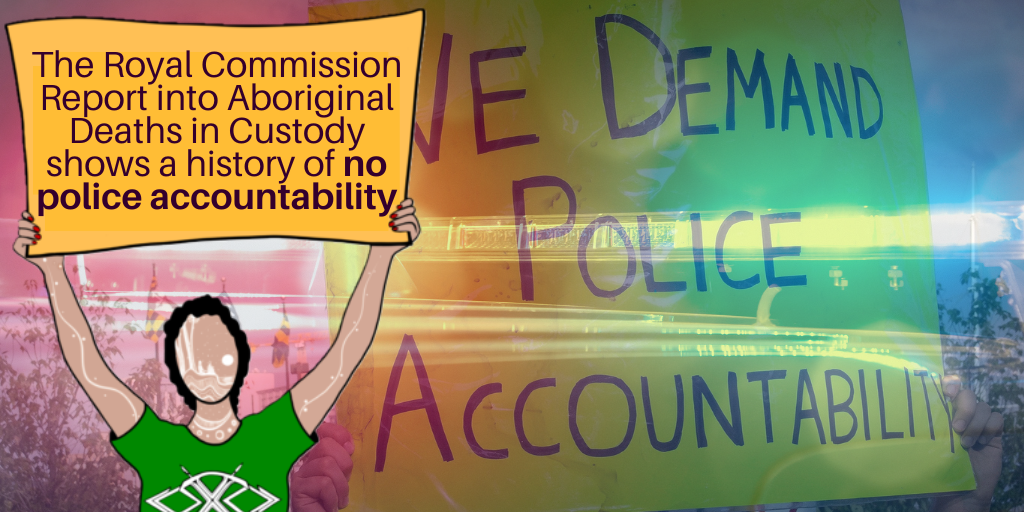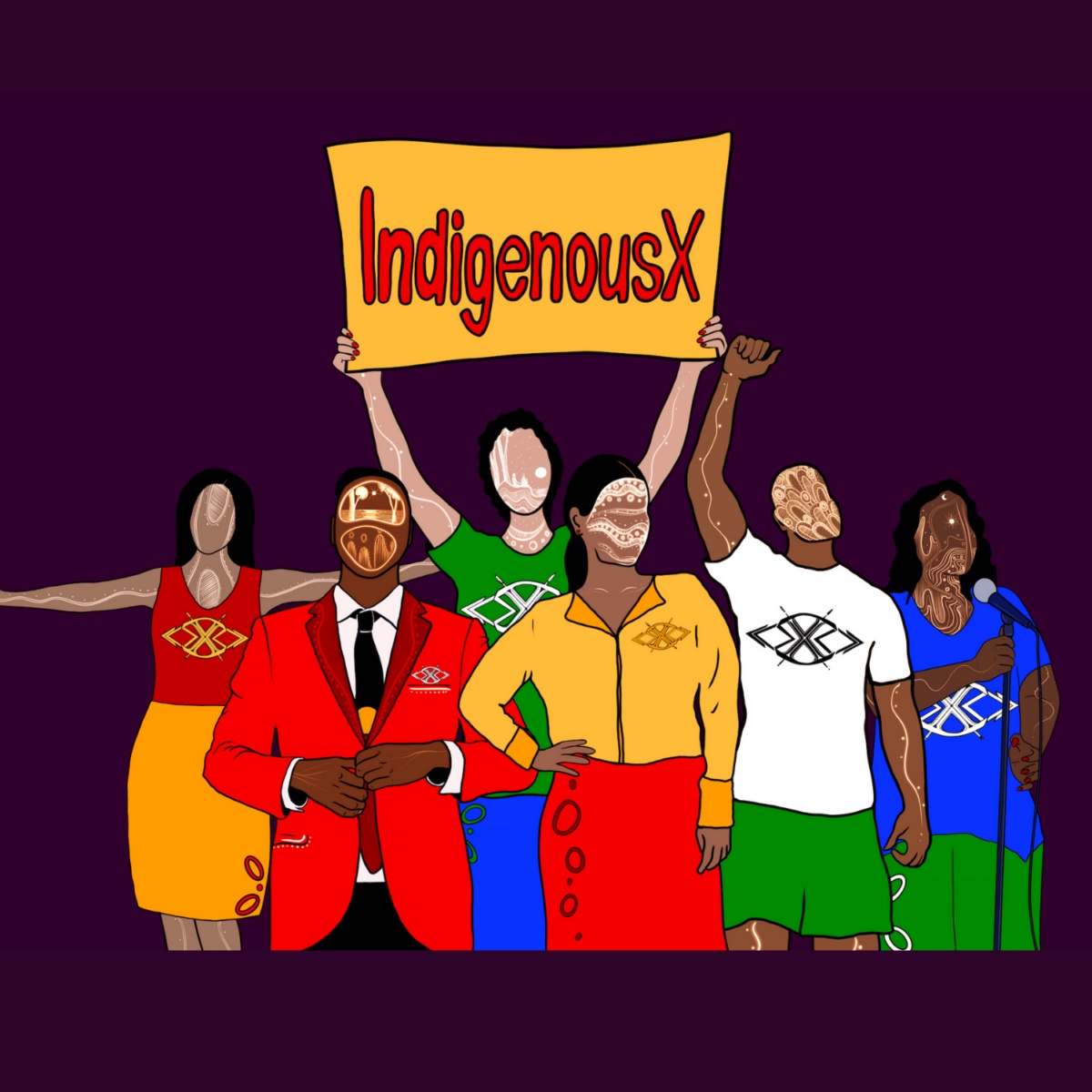The Royal Commission Report into Aboriginal Deaths in Custody shows a history of no police accountability

Readers please be advised this article mentions harm against Aboriginal people, deaths in custody, names of people who have passed away, and racist terminology.
In Toowoomba, Queensland, Steven Nixon-McKellar died from cardiac arrest after being violently wrestled to the ground as a police officer shouted ‘Choke him out!’ and Steven was placed into a “sleeper” chokehold. Warlpiri teenager Kumanjayi Walker was shot dead in his home by police officer Zachary Rolfe. Rolfe’s history of violence and racist behaviour was later revealed through the discovery of his past text messages such as ‘… ha ha, coons man…’. Dunghutti man David Dungay was held down, sedated and his cries ignored as he repeated the words of George Floyd, and so many others: ‘I can’t breathe’.
Because this revolving door of Blak deaths is the same story over and over again, you’d be forgiven to think these Aboriginal deaths in custody happened many years ago and not all within the last five years. A lot of us have grown up hearing these stories. Eddie Murray, 1981, found hanging in his jail cell with a broken sternum; David Gundy, 1989, shot to death in his home; Cameron Doomadgee, 2004, died of massive internal injuries in a police cell; Kwementyaye Briscoe, 2012, left to die in a police cell; Aunty Tanya Day, 2017, who left unattended in a prison cell, sustained a head injury which would later kill her. This year alone, These historic deaths bear striking resemblance to the names above, and others who continue to die in police custody.
I primarily draw on Volume 1 of the Royal Commission and the individual death reports, as this article is about the overall arguments of the Royal Commission and lack of accountability when it comes to police violence.
Some of the findings of the Royal Commission into Aboriginal Deaths in Custody
While only some of these deaths were investigated in the 1991 Royal Commission into Aboriginal Deaths in Custody (which I’ll refer to as the Royal Commission), they all have something in common. Not one police officer was ever convicted of murder, manslaughter or even negligence at the bare minimum in relation to these deaths. In fact, in the history of Aboriginal deaths in custody, not one police officer has ever been held accountable.
In fact, in the 1991 Royal Commission into Aboriginal Deaths in Custody Report, no police officer bore any responsibility for the 99 deaths examined in the timeframe from 1980 to 1989. At its core, the Royal Commission’s report is an anthology of victim-blaming and presumed police innocence, as we see in this quote from Commissioner Johnston in Volume 1 page 18-19 of the Royal Commission Report:
‘…As the individual reports of the deaths indicate, generally speaking the standard of health of the ninety-nine varied from poor to very bad … their economic position was disastrous and their social position at the margin of society; they misused alcohol to a grave extent …’.
In Volume 4 of the royal commission report, Johnston acknowledged ‘institutionalised and systemic’ racism was a problem. Despite this, the Royal Commission did not hold any police officer accountable, and institutional racism continues to run rampant. We still see this impunity today, with officers’ freedom to inflict violence and negligence on a people they refer to as ‘Neanderthals’ and ‘coons’ in their texts to each other. Not long after the Royal Commission’s report, in 1992, footage was found of police. Dressed in ‘black face’, they walked around with nooses around their necks, mimicking and mocking such deaths as David Gundy and Lloyd Boney.
A blatant and terrifying message was sent to the First Nations community that day: We’ve gotten away with it and we’re going to keep doing it.
History doomed to repeat itself
There have been over 500 Aboriginal deaths in custody since the Royal Commission report was handed down in 1991. Considered a revolutionary report at the time, the Royal Commission has done nothing towards helping our people who are dying at a greater rate than before the commission, increasing from 10.5 deaths a year to 15.1. Yuin academic Dr Amanda Porter has argued this crisis has far more distressing numbers than is reported, acknowledging the Australian Institute of Criminology statistics ‘significantly underestimate the scale of the crisis’ because of loopholes on what qualifies as an Indigenous death in custody.
The Royal Commission’s report did acknowledge the caretaking of First Nations inmates was lacking and investigations after the deaths in custody did nothing to quell suspicions of foul play. I would argue the Royal Commission has hindered our fight to keep our community safe. This is because while it acknowledges and even defines what institutional racism can look like, there are no actual consequences for when this racism has been put into practice. This has instead resulted in 31 more years of violence inflicted on dehumanised Blak bodies and/or negligence when they are in legitimate medical distress.
The report admitted there was a strongly held view among the Indigenous and non-Indigenous community that at least some of the deaths were caused by purposely inflicted injuries by the police, but dismissed this view as unsubstantiated:
‘In the final analysis, as a result of rigorous inquiry and the free flow of information, there were very few cases where foul play was alleged at the conclusion of the inquiry. I hasten to add that in many cases a lack of care on the part of custodians was alleged (and in many such cases found to have occurred), but the pre-existing suspicion of a large number of deaths brought about by deliberate violence on the part of the custodians was largely dispelled.’ (Johnston Royal Commission 1991, Volume 1, p. 47).
Although the report did acknowledge a failing in police duty of care in Vol. 1 section 1.2.3, it did not address systemic racism being a contributing factor to these deaths. Instead, the report declared none of the 99 deaths was the result of foul play, and yet does not explore why these deaths, even the ones allegedly from natural causes, were within the first 12 hours of being in custody. The report instead argued every death was either caused by previous diseases, self-inflicted hangings, other forms of external trauma and dangerous amounts of alcohol and drugs in the system of the victims. The main reason for this, the Royal Commission stated (volume 1, page 22), was because the Aboriginal community had fallen into degradation, were prone to violence, alcohol, self harm, and low self-esteem from being mistreated in the early colonisation of Australia:
‘The consequence of this [colonising] history is the partial destruction of Aboriginal culture … The other consequence is the considerable degree of breakdown of many Aboriginal communities and a consequence of that and of many other factors, the losing of their way by many Aboriginal people and with it the resort to excessive drinking, and with that violence and other evidence of the breakdown of society.’
The report claims this history explains the over-representation of Aboriginal people in custody, and thereby the death of some of them. These issues somehow emerged as soon as they were put into custody. So in essence, we had fallen into the stereotype non-Indigenous people already had for us. The report then argued the key to helping reduce Aboriginal deaths in custody is to provide Aboriginal people with empowerment and self-determination.
In criminology professor Chris Cunneen’s article, he highlighted critiques of the Royal Commission’s report. Cunneen cited Bill Craigie’s criticism of the Royal Commission’s failure to tackle the issue of judicial racism. Cunneen also included Aboriginal activist and barrister Pat O Shane’s observation that the report seemed to only focus on police officers and prison wardens while not raising the question of bias among court officers.
When you examine these Royal Commission cases further and listen to unbiased research, it becomes evident the Royal Commission left out key evidence in certain case studies, blatantly ignored certain facts and refused to acknowledge the possibility of police violence.
One example of this is in the case of Edward ‘Eddie’ Murray.
The case of Eddie Murray
Eddie Murray’s story has haunted me since my early twenties. On 12th of June, 1981, 1981, Edward was found dead in his gaol cell, hanged by a strip of blanket used as a noose. This was only several hours after being apprehended by the police. The Royal Commission’s report was satisfied Edward hanged himself.
However, there are many flaws in the report’s findings in this case, but I’ll just talk about two. Firstly, the report states Edward was not suicidal, and yet concludes because he was highly intoxicated, it made his alleged aggression to the white community develop into self-hate. This view appears to be built on assumption/opinion, as the authors provided no evidence to back up this claim.
Secondly, the report disclosed that during the hearing into Edward’s death, the on-duty police officers fabricated parts of their story while under oath. But it was ruled these officers lied because of being frightened of being implicated and this in no way meant any part of their story was not credible (Johnston 1991, pp. 19 & 22). Even though people who lie in testimony are normally considered non-credible sources, this somehow changed in the case of these police officers.
The Royal Commission’s report found ‘the autopsy conducted on the deceased was hurried and so poorly recorded that the cause of the death was unclear’; and the coroner would not say if Edward died ‘“by his own hand or the hand of person or persons unknown”’. These post-mortem findings of the coroner are not cited in the Royal Commission’s (1991) report.
More recent findings showed the abuse of power in Edward’s case. 16 years after his death, Edward’s family exhumed his remains to find more evidence supporting foul play: he had a crushed sternum, believed to be caused before he was hanged. Even if the crushed sternum was not caused by police officers and happened if Edward fell against something, such an injury, combined with his blood alcohol level of 0.3%, would have made it practically impossible for Edward to hang himself.
Despite being presented with these new revelations, the New South Wales Police Integrity Commission refused to conduct another investigation into Edward’s death. This continues to show police are not being held accountable for crimes because the system is flawed where we have police investigating police, and a judicial system still rife with racism.
This is not the only example of misguided justice the Royal Commission continues to insist is the fault of the Aboriginal community. In 1983, Yindjibarndi 16-year-old John Pat died after being struck in the face and kicked in the head by a policeman as he lay limp on the ground. This resulted in a lengthy trial where all police involved were found not guilty despite blood found on two of the officers’ boots matching the same blood group as John Pat’s .
Then there’s David Gundy, who was killed when police raided his house looking for another suspect. The Royal Commission’s case profile on David Gundy (found on page 8-9), appears to praise the officer who shot David: ‘Whatever shortcomings there were in the police actions are not matters for personal blame of Dawson, who was courageously and competently carrying out what he had been required to do, in the way that he had been trained to do it’.
Time for Accountability
The Royal Commission’s report’s refusal to acknowledge police violence, excluding important evidence, and using racialised language, shows the report is a dated document that needs to be re-examined in order to achieve justice and accountability for the violent deaths of our people. Without accountability, we will continue to have another string of names we will cry out for justice for, all with similar injuries, suspects and ignored incriminating evidence. Because police are allowed to act with power unchecked by anyone but themselves, they open permission to continue to devalue Indigenous lives.
The Royal Commission perpetrates problematic assumptions around Aboriginal people’s lifestyles, using patronising language to reinforce a paternalistic view of Indigenous people and the racist, mainstream perception of our inability to govern ourselves.
The reality is, the report was never about our self-determination; it was always about redirection, trying to get First Nations people to concentrate on our so-called ‘role’ in our deaths, rather than recognising the violence being inflicted on Blak bodies.
The Royal Commission’s report started some important discussions for its time, and First Nations peoples’ stories are an integral part of its conception. However, we need to acknowledge its shortcomings and have our people be the ones taking the lead when trying to find solutions to protect our people, while no longer having police investigating police misconduct. There can be no true justice when officers continue to be protected from consequences for violent or racist actions. We should be looking to Blak voices when discussing topics like this, like Apryl Day (Aunty Tanya Day’s daughter), who founded the Dhadjowa Foundation; and Samara Fernandez-Brown (Kumanjayi Walker’s cousin), coordinator of the ‘Justice of Walker’ campaign, and also a member of the Dhadjowa Foundation, both of whom are advocating for proper support for families who have lost loved ones in custody, or Amy McQuire, whose work concentrates on the institutional racism in both the police and court systems.
According to the ABC, only two-thirds of the 339 recommendations in the Royal Commission’s report have been implemented. While some of the recommendations of the Royal Commission would have been helpful if actually implemented, like trying to reduce contact between police and Aboriginal citizens, the issue still remains: if the only way to keep our people safe is to make sure they have no contact with the justice system, that isn’t safety. It’s a dangerous band-aid solution.
You don’t help a victim by telling them to stay away from their perpetrator; you help the victim by holding the perpetrator accountable before they kill someone.
If the themes in this article have caused distress, here are some resources that may be helpful:
- 13YARN (available 24/7): 13 92 76
13Yarn factsheets here - Brother to Brother 24 hour crisis line: 1800 435 799
- The National Indigenous Postvention Service – After Suicide Support 24/7: 1800 805 801
- Yarning SafeNStrong (available 24/7): 1800 959 563





